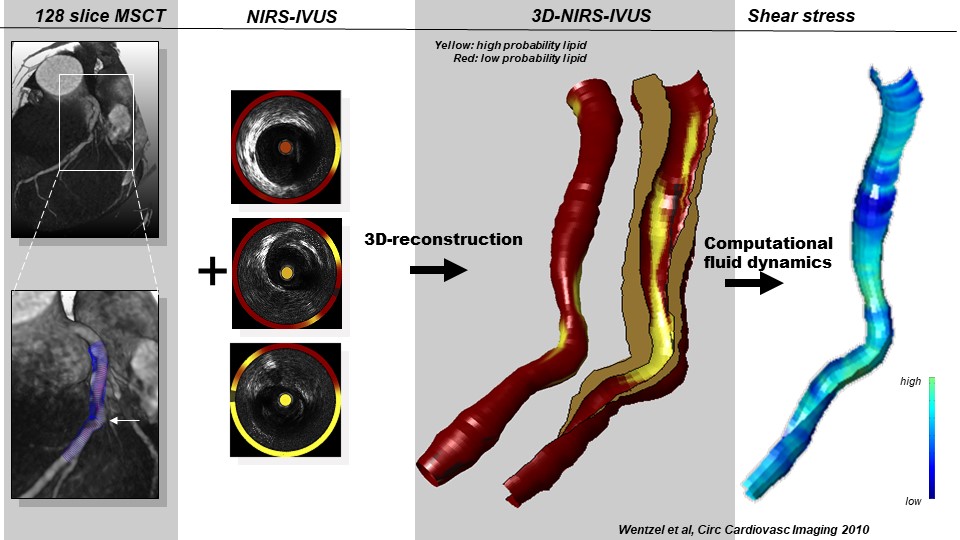What we do
About our project
Atherosclerosis is the leading cause of death world-wide and atherosclerotic plaque rupture is the underlying pathology related to the majority of cardiovascular events. Biomechanical forces are known to be involved in the initiation, progression, destabilization and rupture of atherosclerotic plaques. Therefore, we envision a role for biomechanical stress to identify plaques at risk to be used during clinical decision making.

Our research focus
In our studies we make use of in vitro studies, (pre)-clinical models of atherosclerosis and patients. During the different phases of the disease, atherosclerotic plaque progression is monitored using (non)-invasive imaging and plaque tissue is collected. Acquired images are used to 3D reconstruct the lumen and vessel wall of the artery under study. Using image based modeling the local stress in and at the vessel wall are computed using finite element modeling (see figure) and finally linked to local changes in the vessel wall, including the vessel wall composition. This methodology allows for a very detailed analysis of the influence of local stress on the pathophysiology of plaque changes.
Funds & Grants
- ERC
- VENI
- TTW
- INSILC
Collaborations
Internal collaborations
- Cardiology
- Internal medicine
- Epidemiology
- Radiology and Nuclear Medicine
External collaborations
- Department of Biomechanical Engineering, 3ME, TU Delft, the Netherlands
- Prof. Umberto Morbiducci, Politecnico di Torino, Torino, Italy
- Prof. Peter Stone, Bigham and Women’s Hospital, Harvard Medical Center, Boston, USA
- Prof Alfons Hoekstra, UVA, Amsterdam, NL
- Prof. C Bouten, Eindhoven University of Technology
Publications
- Hoogendoorn et al. Multidirectional wall shear stress promotes advanced coronary plaque development - comparing five shear stress metrics. Cardiovasc Res. 2019 Aug 22. pii: cvz212. doi: 10.1093/cvr/cvz212.
- Gijsen et al . Expert recommendations on the assessment of wall shear stress in human coronary arteries: existing methodologies, technical considerations, and clinical applications. Eur Heart J. 2019 Nov 1;40(41):3421-3433. doi: 10.1093/eurheartj/ehz551
- Moerman et al. An MRI-based method to register patient-specific wall shear stress data to histology. PLoS One. 2019 Jun 6;14(6):e0217271.
- Kok et al. The influence of multidirectional shear stress on plaque progression and composition changes in human coronary arteries. EuroIntervention. 2019 Oct 20;15(8):692-699.
- Barrett et al., Calcifications in atherosclerotic plaques and impact on plaque biomechanics. J Biomech. 2019 Apr 18;87:1-12,
- Meester et al., Imaging of atherosclerosis, targeting LFA-1 on inflammatory cells with 111In-DANBIRT. J Nucl Cardiol. 2019 Oct;26(5):1697-1704.





